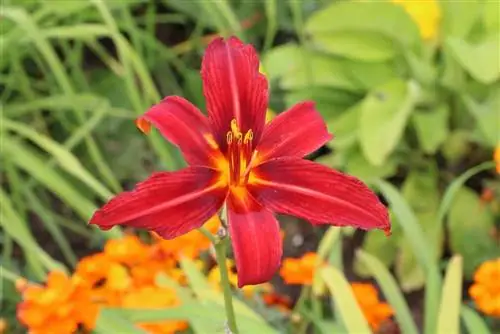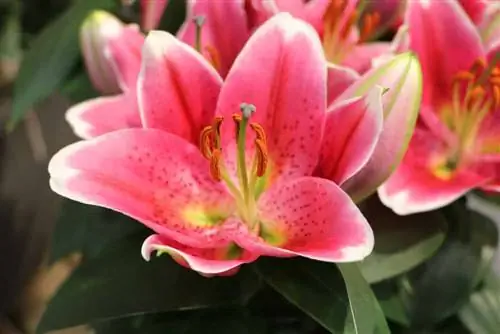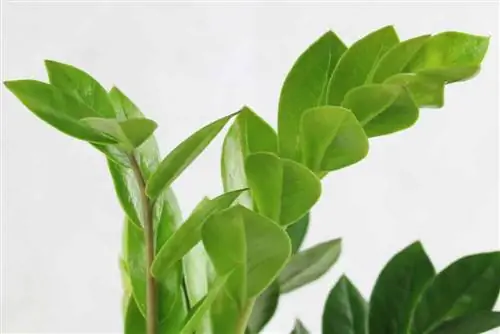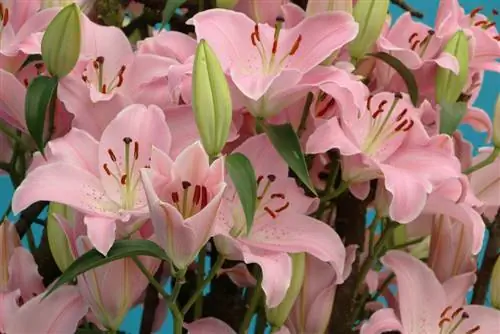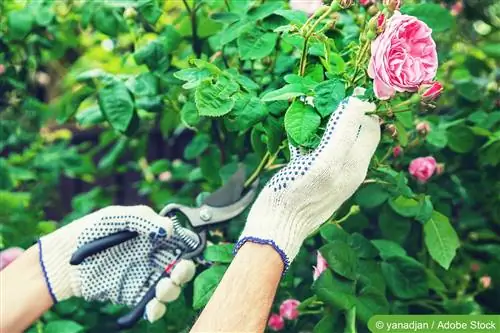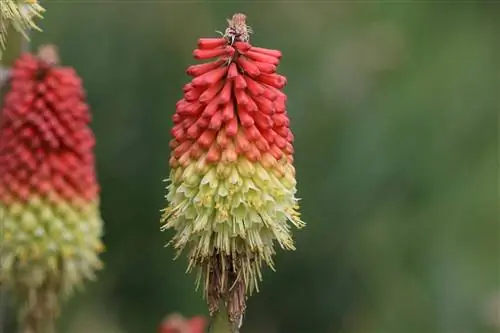- Author admin [email protected].
- Public 2023-12-17 03:39.
- Last modified 2025-01-24 12:45.
Lilies are a real feast for the eyes in every garden. They ensure that something like a seductive, exotic flair is possible even in our latitudes. If you don't have your own garden, you still don't have to go without this fantastic plant. With a little know-how, lilies can be easily cultivated in the home. The amount of care required is really limited.
Lilies
Lilies, whose Latin name is simply Lilium, belong to the lily family, which includes a total of around 115 species. The plant grows from a bulb and, depending on the species, can reach a height of more than three meters. Lilies are characterized by their very striking flowers, which vary greatly in shape and color. This is primarily why lilies are valued almost worldwide as ornamental plants. It is not for nothing that they are considered to be the oldest ornamental plants in the world. Lily plants originally come from the Himalayan region. However, they are now widespread across the entire northern hemisphere of the earth. They prefer a temperate climate and love the sun. Lilies are particularly perennial plants.
Lily bulbs
As already mentioned, lilies grow from a bulb. Lily bulbs are egg-shaped and are made up of numerous individual scales. They do not have a protective onion skin. If you want to cultivate lilies yourself in the garden or as a houseplant, it is best to buy lily bulbs from a specialist retailer. The onion is then also used for reproduction. And the lily is ultimately overwintered via the bulb. It is ideal to always plant several and, if possible, different bulbs in a group. In this way, a wonderful lily ensemble with different flowers is created.
Lilies in a pot
Lilies are actually typical garden plants that thrive best outdoors. Nevertheless, they are also suitable for cultivation on the balcony or in the apartment. Of course, a planter is essential for this. When choosing this planter, the most important thing is the size. This in turn depends on whether just a single lily bulb should be planted or a whole group. It should be noted that the onion must disappear into the ground to a depth of at least 15 to 25 centimeters. The planter should therefore have the appropriate depth or height.
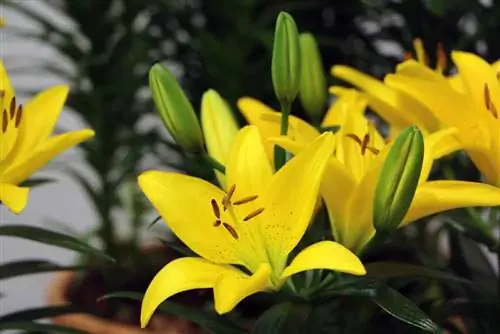
For a single plant, a diameter of around 20 centimeters is completely sufficient. If several onions are combined into a group, a significantly larger diameter is of course required. A distance of around ten centimeters between the individual bulbs is recommended. However, a distance of around 15 centimeters is even better.
Tip:
The planter should be a little larger to give the lily the opportunity to fully develop. Large planters that have a hole on the bottom to drain water are ideal.
Varieties for the pot
Not all lily species or varieties are equally suitable for cultivation in a pot. The best results are achieved when you choose rather short-growing varieties. Ideal are:
- Avignon
- Marco Polo
- Mona Lisa
- Le Rève
If you still want to use tall-growing varieties such as “Anges Dream” or “Royal Wedding”, the planter must be correspondingly large. Accurate sizing is difficult. Basically, it can be said that it actually can't be too big.
Planting onions
The best time to plant lily bulbs is undoubtedly spring. Conventional potting soil is suitable as a planting substrate. But the plants also do extremely well with cactus soil or a mixture of potting soil and granules. It is only important that the substrate offers good water permeability, as lilies cannot tolerate waterlogging. The bulbs are planted loosely in the substrate to a depth of 15 to 25 centimeters. If several onions are combined in one container, the distance between them must be around 15 centimeters. Water immediately after planting.
Tip:
Never place the pot with the lilies in a saucer to avoid possible waterlogging.
Location
Lilies like and need sun. A sunny, bright location is therefore strongly recommended. However, lilies cannot tolerate full midday sun. Of course, this must be taken into account when choosing the right place. Under no circumstances should it get too hot for the plant. If you want to cultivate your lilies on the balcony, you should always keep in mind that it can get excessively hot there.
An ideal location is facing west or southeast. If the lily is on the terrace or balcony, it should also be protected from wind, as it can quickly become dangerous for the sensitive flowers. At the same time, it is also important to ensure that the plant is not too close to a wall to avoid possible heat build-up.
Care
If you remember the splendor with which lilies bloom, you could easily come to the conclusion that they require an incredibly high level of care. In reality, exactly the opposite is the case. Lilies are also extremely easy to care for as potted plants and require little attention. However, they need to be watered regularly. In summer this even has to be done every day. These principles apply generally to the care of lilies:
- Watering regularly and definitely avoiding waterlogging
- fertilize every four weeks from June
- cut off wilted flowers immediately
- Prune plants in autumn
Pouring
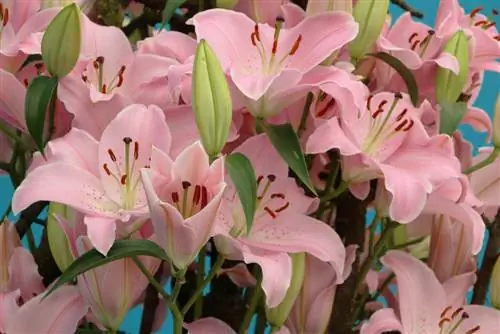
Regular watering is extremely important for the lilies to thrive. However, too much water can quickly cause the plant to wither. The best way to find the right level is to repeatedly test the moisture content of the soil surrounding the lily. As a rule of thumb, it should be superficially dry between each watering, but under no circumstances should it dry out. The surface will dry out relatively quickly in a warm or even hot summer, which is why daily watering is definitely recommended.
Wintering
Lilies are surprisingly robust plants that can cope well with very cold temperatures. Their bulbs are even hardy and can be left outdoors even when there is snow and ice. It is still advisable to overwinter lilies in pots - especially if they have been cultivated as houseplants. In any case, they must be taken out of the heated apartment and into a place that is as cool as possible, where they should remain throughout the winter. Beforehand, all above-ground plant parts must be radically cut off to prevent possible mold formation.
The onion can safely remain in the pot or in the planting substrate during the winter. However, the soil should be as dry as possible. And you should also completely avoid watering during the winter months. Alternatively, the onion can also be dug up, cleaned of soil and stored in a cool, dark room. It can then easily be replanted next spring. However, care must be taken to ensure that the potting soil from the previous year is not used.
Diseases and predators
If the site conditions are right and watering is sufficient, but not too much, lilies in pots are hardly susceptible to disease. However, they can be threatened by certain fungi and viruses. Yellowing of the leaf tips usually indicates that the plant is diseased. But it is usually too late to save the lily. It only helps to dispose of the plant. The soil must also be disposed of at the same time. There may be fungal spores in them that would be dangerous if the next plants were reused.
If you have your lilies on your balcony or terrace, you may have problems with predators. Particularly worth mentioning here is the large lily chicken, a red beetle whose larvae can eat the plant bare in a very short time. Regular inspection of the leaves and stem is therefore necessary. If you discover one of the animals, the entire plant should be showered intensively immediately.
Lilies and cats
Lilies in pots that are cultivated in the apartment or on the balcony often come into contact with pets. Cats in particular tend to nibble on the plant. However, this is not good for the lily or the animal. The plant parts are highly toxic to cats. The plant sap that the animals ingest can lead to kidney failure or incurable kidney disease, from which the cat inevitably dies. It is therefore strongly advisable to place the lilies in the apartment in such a way that a cat definitely cannot reach them.

